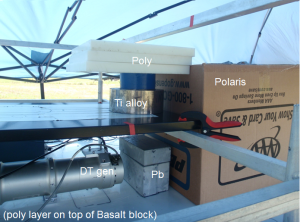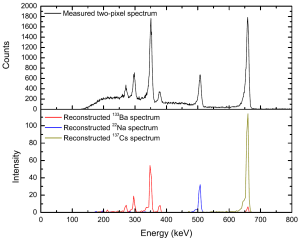Commercial Partners
- H3D, Inc.
- Redlen Technologies
- eV Products
- Ideas – Integrated Detector Electronics AS
- Radiation Monitoring Devices, Inc.
Current and Past Collaborations
Dr. Gianluigi De Geronimo – On digital H3DD ASIC (joint project between UM and BNL)
The latest analog-electronics readout prototype system was built in 2012 in collaboration with H3D, Inc., Brookhaven National Laboratory (developers of the next-generation analog readout electronics), and LocoLabs, LLC (responsible for rapid-prototype design of the integrated system). Due to improvements in the readout electronics, these systems achieve 0.9% FWHM at 662 kev for all events combined.
The BNL analog direct-attachment readout and BNL digital readout systems are currently in the design process. With less electronic noise and more flexibility, it is anticipated that these readout systems will have better performance.
Professor Jerimy C. Polf of University of Maryland Medical School on proton cancer therapy
An H3D Polaris system is used by the University of Maryland to measure proton beam profiles via secondary gamma-ray emissions.Real measurement data is shared with the Orion Group to develop and test fast, 2/3D image reconstruction algorithms. With more accurate beam profile quantification techniques treatment dose to healthy tissue can be greatly reduced.
Dr. Justin Knowles and Dr. Martin R. Williamson of Y-12 (SNM detection, characterization, and quantification)
The ongoing measurement campaign at the Y-12 National Security Complex in Oak Ridge, TN is part of the DOE “Black Box” project. The Nuclear Detection and Sensor Testing Center at Y-12 is intended for use by researchers and provides an accessible facility for us to measure enriched uranium samples. Both the digital Orion and analog Polaris SP systems made the trip to Y-12 in the spring of 2015 to acquire data. Various methods for estimating uranium enrichment and 2-D shape were successfully applied during this trip. The next set of measurements will be focused on 3-D imaging and estimating the Z number and thickness of various shielding materials for correcting gamma-ray spectra leaving shielded uranium objects. Future measurements will attempt image-quantification using the Orion detector system for hold up application.
Dr. Dean J. Mitchell of Sandia National Laboratory
In collaboration with Sandia National Laboratories, the well-established ADRAS (Gamma Detector Response and Analysis Software) will utilize the imaging capability of 3D position sensitive detectors. With the energy-image integrated deconvolution (EIID) algorithm, it is possible to provide a spectrum as a function of incident angle, and autonomously detect isotopes of interests and point to their direction.
The spectra at three different directions of the sources with the EIID algorithm. The sources at different directions are clearly identified by the spectra, and the continuum is removed.
NASA Goddard Spaceflight Center
Researchers at NASA’s Astrochemistry Laboratory contacted our group during the summer of 2012 because they were interested in using our 3D CdZnTe technology for a special application of neutron activation analysis (NAA). The proposal was to use a spacecraft-mounted neutron generator to interrogate celestial terrain and detect the delayed gamma-ray signal using a spectrometer. However, since the generator emits neutrons in all directions, activation of the spacecraft is unavoidable. This confounding signal, along with the cosmic ray background, tends to drown out the NAA signal from the terrain. This is where our Polaris technology is particularly helpful. Using the directional information offered by Compton imaging, it’s possible to determine the gamma-ray spectrum as a function of direction and ignore the background signal from the sky and spacecraft.

Measurements were taken at NASA’s Goddard Spaceflight Center to test if Polaris II was capable of distinguishing the directions of different neutron-activated materials. Polaris II was placed on a large basalt block, which simulated the celestial body, along with a D-T neutron generator, polyethylene, lead, and titanium. The data was processed and Compton images of the various lines emitted by the activated materials were formed. These images successfully showed the direction, and in some cases the shape, of the surrounding materials, indicating that the Polaris technology was indeed capable of directional NAA.
Dr. Christopher Morris and Dr. Zhihui Wang of Los Alamos National Laboratory – SNM detection
Professor Lei Cao of OSU (on thermal neutron measurements and imaging)


